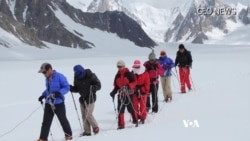“You’ll miss this food at base camp. Have some more.” Nazir Sabir pushed the plate of perfectly broiled mutton chops toward his Western guests.
The first Pakistani man to climb Everest, he now runs a successful business organizing mountaineering expeditions inside Pakistan.
On this night last week he was host to a team of 12 mountain climbers and 11 of their Sherpa helpers at a chic restaurant in Islamabad. Dinner included several varieties of grilled meat and fish marinated in Pakistani spices.
They are now off to K2, part of an expedition organized by Himalayan Experience, a company that New Zealand mountaineer Russell Brice began in 1994. Sabir’s company acted as the local coordinator for Himalayan Experience.
The multinational team included a British mountaineer, David Tait, who climbs to raise funds for a British charity, the National Society for the Prevention of Cruelty to Children.
Over the years he has raised almost $15 million for the cause. With the Himalayan Experience expedition to K2, he hopes to raise at least a million more.
Tait has climbed Everest five times since 2005, once every two years. Each time he departs, he leaves behind an envelope for his wife, marked “to be opened in the event of my death.”
This year, he feels the chances that his wife might have to open that envelope are much higher.
“It’s not an easy decision to leave your family," Tait said, "but it's made doubly difficult now, because the risk is doubled. Suddenly we’re targets.”
He was referring to an attack on June 22 two years ago: Armed men in paramilitary uniforms, claiming to be Taliban, stormed a climbers' base camp on Nanga Parbat - at 8,126 meters, Pakistan’s second highest peak. The gang slaughtered 10 foreigners and one Pakistani national.
The tremors from that attack shook the world's mountaineering community, and the shivers remain.
Team member Nick Ciensky, an American from Baltimore, remembered that two years ago every climber was asking: "Now what?"
After such violence, what would be the future of Himalayan mountaineering?
Since Pakistan is home to five of the 14 mountains worldwide that rise higher than 8,000 meters, serious mountaineers were devastated by the thought that they might lose access to those peaks as a result of the Nanga Parbat attack.
Ciensky said their fear was this: "If this happened once, can it happen again? And can it happen ... anywhere in the country?”
He was in Pakistan as part of his effort to establish a world record by climbing six of the 8,000-meter peaks in one year. Four of those - K2, Broadpeak, Gasherbrum I and Gasherbrum II - are in Pakistan, but he is still giving Nanga Parbat a wide berth.
“For my level of security and my level of what I hope to achieve, it would just be an unnecessary risk to take,” he said.
After Pakistan he plans to climb two peaks in Tibet, and then one more in Nepal in early October. The seventh would be "insurance" in case something goes wrong on one of the other climbs.
Other people in the team have calculated the risks and are trying to manage them in similar ways, but it's becoming difficult. And expensive.
High-altitude climbing gear costs thousands of dollars. Then there's the cost of travel, local staff, permits and other expenses. It costs at least $20,000 per person for a group of 10 or more to climb K2. Not many climbers can afford that - most need sponsorships. Others do it for a cause, and need promotional help. In either case, they need publicity.
But Brice, who knew some of the people killed two years ago, had to balance the need for publicity with the need for safety on this trip.
“I’ve been saying to our members: Let’s be very quiet and low key. Let’s not make too much promotion, so it doesn’t attract attention to us,” he said.
He has discussed security with his team, not just on the mountain but also on the road and in the cities.
Sabir, who organized the ill-fated expedition to Nanga Parbat in 2013, tries to minimize the lingering impact that trekking and mountaineering have on the environment in Pakistan, but there also is the question of climbing's effect on the local economy.
Many people in the Himalayan region depend on tourism, especially from climbers, for their livelihoods. With mountaineers wary about coming here, they now find it hard to make a living.
“Whatever little tourism was left in Pakistan after September 11 was in the mountaineering community,” Sabir said, referring to the attacks on New York City's World Trade Center and the U.S. government in Washington 14 years ago. “Nanga Parbat was another 9-11 for this community.”
He hopes things will get back to normal, as do most of the others with him in Islamabad on that recent evening.
The randomness of the Nanga Parbat attack makes climbers like Briton David Tait philosophical, but also somewhat resentful.
“Life and death in the mountains is not something that people take lightly,” Tait said, adding that he understands all the risks, and does not expect to be rescued in case of an accident or an avalanche.
“I take those risks anyway because the benefits are huge," he said. "But I do resent the fact that someone feels it is within their power to come along one day and just snuff out my life.”








